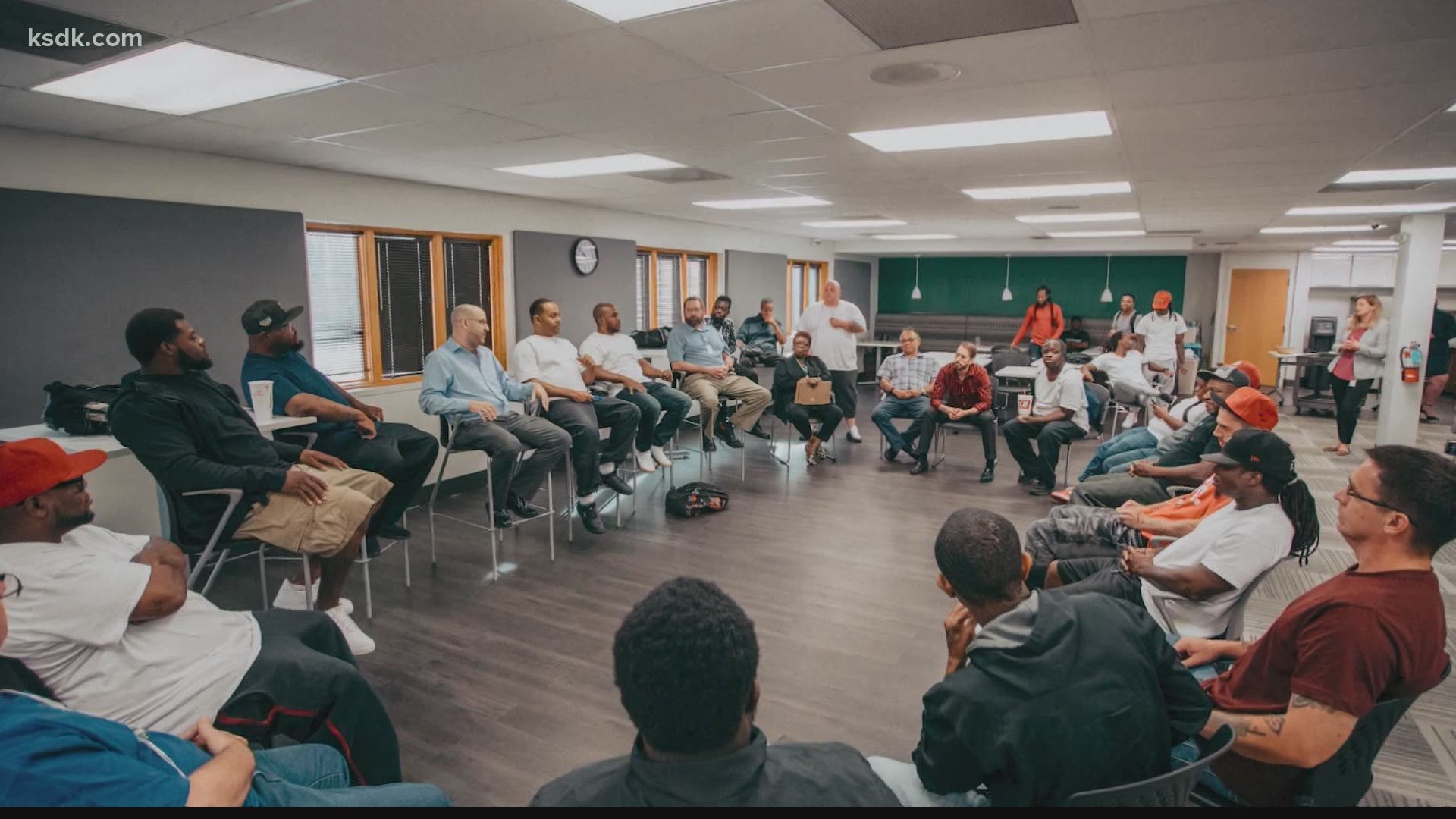ST. LOUIS — Editor’s note: This is the first in a three-part series about Concordance Academy of Leadership, a nonprofit post-prison rehabilitation program aimed at reducing recidivism. The next installments in the series will highlight the stories of the participants, past and present.
ST. LOUIS COUNTY, Mo. — Danny Ludeman once had what many might consider a dream job.
As CEO of Wells Fargo, he was in charge of giving away $20 million to philanthropic organizations across the country each year — about half of it stayed in the company’s hometown, St. Louis.
But for as much joy as it brought him, his Fortune 500 company and the nonprofits who depended on those gifts, the now-retired executive confessed he couldn’t shake his business sense from creeping into his mind every time he cut a check.
“My concern, which is probably the biggest issue in philanthropic dollars, is I really could not tell what impact my giving to these organizations was having,” he said.
He retired six years ago and has been working to build an organization that he can prove works ever since.
It’s called Concordance Academy of Leadership. Ludeman says it is repairing lives and reuniting families by reducing recidivism.
The agency set out to reduce the reincarceration rate among its participants by 33%.
It’s done it by 44%, he said.
“There’s no other organization on the planet that comes close to that,” Ludeman said.
Ludeman still has friends in high places, holding the strings to multi-million-dollar philanthropic giving purses.
A national campaign to raise $50 million is underway to expand the Concordance Academy model to 11 more cities across the country.
But Ludeman didn’t want to build a program that is completely dependent upon the charitable giving of corporations. So, he’s also come up with a plan to convince state leaders to pay for the program by showing how much money the state can save by keeping people from returning to prisons.
Staying true to his business-minded roots, he calls his pitch to potential corporate and governmental sponsors “a value proposition.”
“We don't want to attract people to us just because they have a big heart,” he said. “If we can't add value, then they ought to fire us and that's my message to all of them.”
How it began
At 57, Ludeman knew he wasn’t ready to completely retire.
A board member of an organization dedicated to helping people coming out of prison read about Ludeman’s plans to get into nonprofit work. She asked him to lead the nonprofit, but he wasn’t ready to commit to a full-time job at the time.
That’s when he first heard the stat that has stuck with him about recidivism.
“Seventy-seven percent of people recommit a crime in the first five years,” he said.
So he drew again on his business roots and agreed to do a strategic plan on how to reduce that rate, starting the formation of a strategic committee. It grew to 70 people and included mayors, county executives, police chiefs, researchers, business and academic leaders and others.
“The one question that group was trying to answer was, with proper resources, leadership and only using evidence-driven practice, could you materially lower the rate of incarceration?” he said.
The group met for about nine months and partnered with experts at Washington University to come up with the re-entry model.
In 2015, Concordance Academy of Leadership opened in St. Louis County with a dozen services under one roof.
“It's almost like an EAP (Employee Assistance Program) that you would see at companies that I led,” Ludeman said.
Leaders partnered with the Missouri and Illinois Department of Corrections to find participants.
“You tend to find that a lot of people that go through the trouble of finding an organization, and filling out an application tend to be your most willing participants,” Ludeman said. “And what we're trying to do is make sure that we're not tapping into the 23% that would make it anyway.”
The Department of Corrections in Missouri and Illinois send names to Concordance team members, who then meet with candidates to gain their consent. The first class had 17 participants. Now, the agency launches classes with 42 participants every other month. In all, about 700 have participated in the program, Ludeman said.
“We need to assure people that we're serving a broad sample of people and that our program will work for anyone, whether they're willing initially at first or not,” Ludeman said. “That’s a big distinction between ours and other programs.”
What it costs
The average cost per participant is $10,000.
“It’s expensive, but the cost of reincarceration is much more expensive to society than $10,000 per person,” Ludeman said.
“When people come out of prison, they return on average seven times,” Ludeman said. “So they’re not just coming out once, they go back and back and back and they call it doing life under the installment plan.”
Knowing how to speak the language executives and leaders like to hear has helped Ludeman gain private, and now public, partnerships to pay for the program.
Throwing around terms like “evidence-based practices,” and “return on investment” helped him land a $2.1 million contract from the state of Missouri in 2020.
He estimates that for every one person Concordance can prevent from going back to prison, the state could save $180,000.
That’s about $4.50 for every $1 the state spends to house an offender.
“The ultimate goal is to have every state pay for this in what we call a Pay for Success contract, which means they don't pay $1 to us until we've shown that we can reduce the rate of incarceration over whatever the state’s states base rate is,” Ludeman said. “The beauty is, once you get these in place, they're not actually allocating the money to us until we show the results, so they're accruing the savings along the way. So once you get one, typically, it can stay in place in perpetuity.”
To get Concordance branches started in other places, Ludeman worked with Dave Steward, the CEO of World Wide Technologies. It’s the largest minority-owned company in the world, with $13 billion in revenue in 2020.
Steward has pledged to help Concordance raise $50 million to expand the program to 11 additional cities during the next five years.
“We truly are breaking down the walls to racial inequality and I would challenge anybody, anybody to find something tangible, actionable, measurable that would have a greater impact on restoring these hundreds of thousands of communities that just are like war zones today,” Ludeman said.
How it works
The program is 18 months long.
The first six begin before a participant’s release, and include meetings with therapists, a career coach and filling a battery of assessments to develop a “life plan.”
It’s what they work on for the duration of their time with Concordance.
“We know everything about our participants,” Ludeman said. “Their home life, their housing situation, their mental health, substance abuse, education level, employment.”
Concordance staff members also work with a participant’s family members, while their loved ones are still incarcerated.
“We’re primarily encouraging the family to let their loved one heal when they come out,” Ludeman said. “If you're a mom and you’ve got four kids, and you're working three jobs because your husband or boyfriend is in prison, you can't wait for them to come home.
“You want them to help out with working or with the kids.”
But the key to Concordance’s success is the healing that goes on before a return to the workforce, Ludeman said.
“Virtually every one of our 700 participants has had a severe traumatic experience by the age of 9,” Ludeman said. “We're talking about they were shot, stabbed, raped, physically beaten or have seen a loved one die in front of them.”
The focus on a person’s mental health is what Ludeman said makes Concordance more successful than other organizations that focus solely on jobs and housing.
“Those are the two biggest myths out there, bar none,” Ludeman said. “Any one of our participants can get a job, but they won't keep it.
“And it’s true, people need housing, but if you get into a housing contract, sign a lease for a year, and you haven’t healed, you’ll be evicted. That's why we spend most of our resources on mental health and substance use treatment because if they don't get that right, this other stuff doesn't really matter.”
An average Concordance participant has four children.
So, Concordance pays its participants to work on themselves.
It translates to about $320 a week, or $1,200 a month.
“It’s not a living wage, but it certainly helps the families buy into this,” he said. “We call it temporary inconvenience for a permanent improvement.”
Life on the outside
Participants spend their first few days on the outside in an orientation phase.
The Bryan Cave law firm formed the Concordance Fellows Program to resolve any outstanding warrants a participant might have so they don’t get re-arrested when they walk out of prison.
Every city has a federally-qualified health center, so participants see a doctor within their first few days of freedom for a physical.
Then, they undergo a six-week treatment program.
For some, it’s an outpatient program. For others, it’s a full-treatment center that includes mental health and substance abuse treatment.
Concordance also has its own employment agency — which is, of course, based in research.
The planning committee worked with the National Chamber of Commerce and identified three industries to target: Food-service, retail and light-industrial.
“Those industry groups we picked are ones that have the most common or most constant demand for labor, relatively speaking, in good times and bad,” Ludeman explained. “Second, they tended to be felon-friendly. Third, they paid a living wage. And then fourth, you don’t need to have a whole lot of skill sets to begin.”
And it’s only a beginning.
Ludeman gave it a business term.
“It’s a 'career blueprint,’ so these jobs are their ‘now’ jobs, their first jobs, then they move into other jobs,” Ludeman said. “Many of our participants are now earning a middle-class income of $60-, $70-, $80-thousand, they're being reunited with their children, it’s just a wonderful thing to see.”
And a dream job to have.
More local news:


